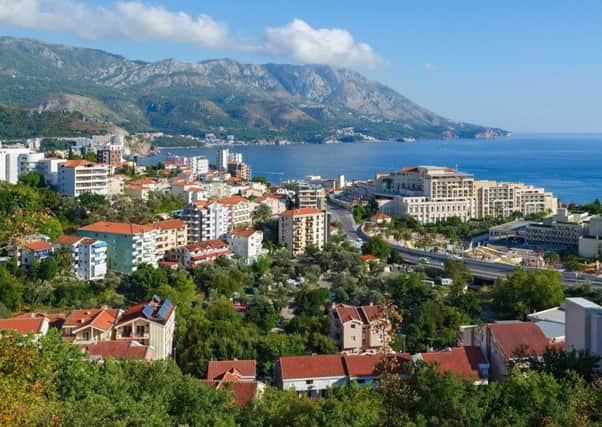Travel review: Montenegro - the new hot ticket


Montenegro isn’t the first place you might think of when planning a family holiday – many people don’t even know where it is on the map. Yet, all this is about to change. Both Vogue and Lonely Planet have highlighted this Balkan country, with its spectacular landscapes, as a top new European place to visit. And travel operator TUI is to launch its first direct, summer flights from the UK to the capital Podgorica from May 3.
Montenegro is about five times smaller than Ireland. Once part of communist Yugoslavia, it became an independent state only in 2006. But this tiny, young nation more than deserves its sudden recognition.
Advertisement
Hide AdAdvertisement
Hide AdLike its neighbour Croatia, it boasts entrancing mountainous scenery, a complex history and medieval towns to explore – but the newcomer is seen as being more affordable.
For our family though, one of Montenegro’s strongest draws is the sense of adventure it offers. After years of playing it safe as parents, sticking to Britain, France and Spain, this feels liberating to me and my husband, Mark. Our children, Max, 13, and Eve, five, are equally enthused.
And all that separates us from our unusual destination is a flight lasting less than three hours. We’re staying in Becici, a family-friendly spot on the Adriatic coast. As we transfer there by taxi, Max grabs his phone and begins taking reams of pictures. “I want to climb all these mountains,” he declares.
Tempting, but as we are visiting in August, the hottest and driest month when temperatures soar into the high 30Cs, that isn’t the most practical holiday plan. Instead, we quickly settle into a morning routine of clambering down the 97 steps that lead directly from our hotel, the Queen of Montenegro, to the 2km Blue-Flagged beach that stretches the length of the town.
Advertisement
Hide AdAdvertisement
Hide AdBecici is pretty touristy, but the pebbly-sandy beach (flip-flops are a must) boasts the clearest, sparkling waters that are blissfully warm in summer, even at 7am.
Less than a 5km bus ride away is Przno, where the tiny bay offers the stunning backdrop of a craggy islet, complete with a ruined watchtower that may once have protected the locals from pirates.
On another day, we discover a path through the woods from Przno, clinging to the shore but shaded with olive and pine trees. It transports us to another world of the rich. Past the grand wisteria-draped Villa Milocer, once the summer residence of the Serbian royal family, and around the corner to a view that stops us in our tracks.
Sveti Stefan is Montenegro’s most famous sight. Connected to the mainland by a narrow causeway, this scenic, fortified island holds a huddle of 15th century stone buildings. We can’t pass the guarded entrance – Sveti Stefan is now part of the luxury Aman resort – but frankly, it doesn’t matter. We snap countless photographs, have a heated debate about how much one stone from the beach would be worth, let Eve try out the free playground and then suck bargain ice-lollies (e3 for four), before catching the bus back to reality.
Advertisement
Hide AdAdvertisement
Hide AdTravelling 5km in the other direction from Becici, we reach Budva, at first sight an ordinary touristy town, with modern buildings on its outskirts. Then we step through the thick walls of the Stari Grad – which means old town – and find ourselves wandering through a maze of narrow, marbled streets, past cannons and churches clustered round the main square, Trg Izmedu Crkava.
This is an ancient place, founded in the 4th century BC as a Greek trading post. The Venetians, who ruled it for nearly 400 years from 1420, first fortified it against other invaders, by erecting its walls.
And yet all is not entirely as it seems – the stones have not all stood fast throughout that time. For after an earthquake struck Budva in 1979, many of the buildings were painstakingly restored.
By evening, we know this fascinating area will be throbbing with visitors, clustering into the restaurants, bars and boutiques. But when we visit in the mid-afternoon heat, it is almost deserted; thankfully, the winding alleys give shade.
Advertisement
Hide AdAdvertisement
Hide AdAlone, Max and I wander around the Archaeological Museum trying to get a better grip on Montenegro’s history. An ancient helmet on display, with jagged holes in the back, bears witness to bloodier times when the town lay on the fault line of the Roman and Byzantine empires.
Emerging back into the sunlight, we find Eve and Mark lounging with smoothies in the shade of a pine tree at one of Budva’s trendiest cafe-bars, Casper.
Heading off together around another corner, we yet again find heaven – or at least Eve’s idea of it. The Pirate Candy Shop offers mountains of sweets, and happiness, in wooden barrels.
Montenegro, with its constant surprises that you just stumble upon without any effort, and blend of touristy fun and intriguing history and culture, offers the perfect family holiday.
Advertisement
Hide AdAdvertisement
Hide AdThe biggest surprise is that it’s taken us so long to discover this beautiful Balkans destination.
GETTING THERE
From May 3, TUI (tui.co.uk) will offer direct flights to Podgorica airport in Montenegro from London Gatwick, Manchester and Birmingham. Accommodation can be booked in resorts including Becici, Budva, Ulcinj and Petrovac.
A seven-night holiday staying at the 4T Avala Resort & Villa in Budva on a half-board basis costs from £579 per person.